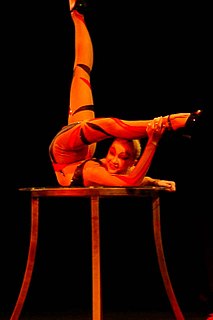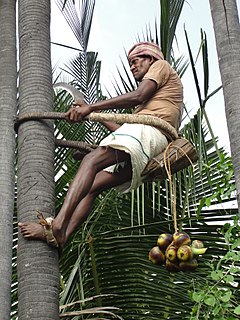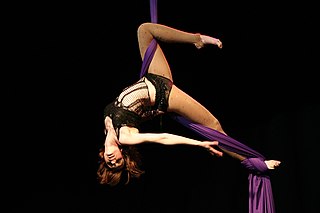The following outline provides an overview of and topical guide to entertainment and the entertainment industry:

Contortion is a performance art in which performers called contortionists showcase their skills of extreme physical flexibility. Contortion acts often accompany acrobatics, circus acts, street performers and other live performing arts. Contortion acts are typically performed in front of a live audience. An act will showcase one or more artists performing a choreographed set of moves or poses, often to music, which require extreme flexibility. The physical flexibility required to perform such acts greatly exceeds that of the general population. It is the dramatic feats of seemingly inhuman flexibility that captivate audiences.

A trapeze is a short horizontal bar hung by ropes or metal straps from a support. It is an aerial apparatus commonly found in circus performances. Trapeze acts may be static, spinning, swinging or flying, and may be performed solo, double, triple or as a group act.

Tree climbing is a recreational or functional activity consisting of ascending and moving around in the crown of trees.

Fire performance is a group of performance arts or skills that involve the manipulation of fire. Fire performance typically involves equipment or other objects made with one or more wicks which are designed to sustain a large enough flame to create a visual effect.

Aerial modern dance is a subgenre of modern dance first recognized in the United States in the 1970s. The choreography incorporates an apparatus that is often attached to the ceiling, allowing performers to explore space in three dimensions. The ability to incorporate vertical, as well as horizontal movement paths, allows for innovations in choreography and movement.

Aerial silks is a type of performance in which one or more artists perform aerial acrobatics while hanging from a fabric. The fabric may be hung as two pieces, or a single piece, folded to make a loop, classified as hammock silks. Performers climb the suspended fabric without the use of safety lines and rely only on their training and skill to ensure safety. They use the fabric to wrap, suspend, drop, swing, and spiral their bodies into and out of various positions. Aerial silks may be used to fly through the air, striking poses and figures while flying. Some performers use dried or spray rosin on their hands and feet to increase the friction and grip on the fabric.

Static trapeze, also known as fixed trapeze, is a type of circus art performed on the trapeze. In contrast to the other forms of trapeze, on static trapeze the bars and ropes mainly stay in place.
Rope is a length of fibers that are twisted or braided together
The cloud swing is an aerial act that usually combines static and swinging trapeze skills, drops, holds and rebound lifts.

The aerial hoop is a circular steel apparatus suspended from the ceiling, on which circus artists may perform aerial acrobatics. It can be used static, spinning, or swinging.

Located in Tallahassee, Florida, the Florida State University "Flying High" Circus is an extra-curricular activity under FSU's Division of Student Affairs. It is one of two such collegiate circuses in the United States along with Illinois State University's Gamma Phi Circus. All members of the FSU Circus are required to be a degree-seeking student registered at Florida State University.

Straps, also known as aerial straps, are a type of aerial apparatus on which various feats of strength and flexibility may be performed, often in the context of a circus performance. It is a cotton or nylon web apparatus that looks like two suspended ribbons. Wrapping the strap ends around hands and wrists, the performer performs holds, twists, rolls and manoeuvres, requiring extreme strength and precision similar to men’s rings in gymnastics. Straps are available in various configurations, including those with various types of loops at the ends and those without loops. A straps act usually includes held poses and postures done on the straps, dance moves performed on the floor away from the straps, partner acrobatics done on and off the straps, as well as having the straps pulled up and let down during the act.
Rigging in entertainment can be broken down into two main subjects – theatrical rigging and arena style rigging. All the same skills apply in both genres. The first takes place in a theatre, and typically involves the theatre's permanent fly system. The other in an arena or "exposed structure venue" such as a convention center, ballroom, warehouse etc. Many arena riggers find themselves hanging a full proscenium theater in an arena environment.
The Philadelphia School of Circus Arts (PSCA) is a contemporary circus school in Philadelphia. It began in June 2008.

Slackwire is an acrobatic circus act that involves the balancing skills of moving along a flexible, thin wire suspended in the air, connected to two anchor points. Slackwire is not to be confused with slacklining.














